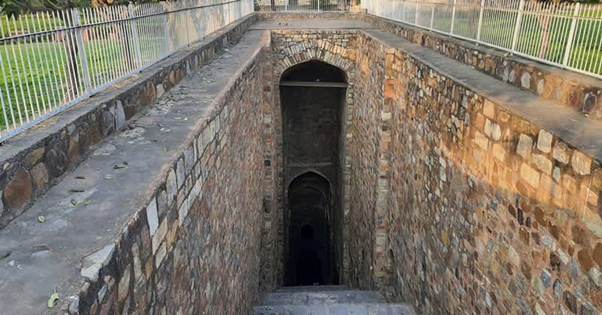
Delhi, the capital city of India, has been the witness of many developments. Astronomy, science, public welfare, polity, parliament: all find their space in this city of constant change. Yet what has lived within ruins and within development has been mere water conservation projects. These projects date back to centuries and had been a source of relief for the people of Delhi as they toiled in its heat, and still decided to give it some love.
Baolis, or stepwells, are water conservation reservoirs. They are wells or ponds, with long corridors of steps leading into them. They were mostly commissioned to be built by the ruling class and interesting fables are associated with Baolis. In many ways, Baolis are not simply water reservoirs. They are carriers of history and myths, and have blended so well with Delhi that they are both unnoticeable yet highly cherished
The role of Baolis in reserving water
Baolis are water reservoirs that stored both underground and natural water. The water served the dual purpose of being used for daily needs such as bathing and considered as drinking water. The primary purpose of the Baolis was to store water. The staircase structure of the Baolis allowed people to access water at different levels without much difficulty. The architectural splendour of Baolis with its shaded boundary walls and many staircases allow the possibility of natural cooling of the water. In the heat of Delhi, it provided people with much needed respite. However, Baolis were not simply sites of water conservation but also places for people to socialize. In olden days, water resources were places where people came for bathing or washing clothes and thus, it became a spot for communities.

Chandi Baoli. Source: Holidify
The Baolis of Delhi
Baolis in Delhi date back to the Sulnate era. They are scattered across the landscape of the city and interesting tales and fables are associated with their existence. While most of these Baolis are not longer functional today, they continue to be important historical and archeological sites and are an important part of the city’s culture and tourism.
The Baoli situated inside the dargah of the sufi saint, Hazrat Nizamuddin Auliya, is an interesting one because of its religious and cultural significance.

Hazrat Nizamuddin ki Baoli. Source: Delhi Tourism
The Baoli at Nizamuddin’s Dargah is associated with mythical tales. It is an 800-year-old Baoli, standing firmly today as a marker of passing time. The Baoli has springs underneath it and worshippers at the Dargah believe that the water of the Baoli can cure them. The sacredness of this Baoli is associated with a tale that connects the sufi said with the ruler Ghiyasuddin Tughlaq. It is believed that Ghiyasuddin Tughlaq had prohibited workers from working anywhere else except at the construction site of his own fort. However, when Nizamuddin Auliya asked the workers to build a Baoli for him, they complied because of the sufi saint’s reverence. The workers decided to work at night to build the Baoli. On one of his inspections, Tughlaq noted how one of the workers was sleeping. Upon inquiry, he understood that they were working at the Dargah against his orders. As a revenge, the emperor forbade oil so that no lights could be lit at night. However, using his magical powers, Nizamuddin lit the lamps with water. It was with such mythical tales that the Baoli was built.
The Baoli at Purana Qila is another interesting one. Having baolis inside forts has very practical implications. The water conservation strategy allows the residents of the fort easy access to water, without much travelling required. The Baoli today is dried up, with stark darkness visible as its steps descend. However, that wasn’t always the case.

Baoli at Purana Qila. Source: So.city
Vikramjit Singh Rooprai is a prominent historian who has written a book on Baolis. In his book, he notes, “When the British decided to clear settlements around the Qila, they called in a team to clear the garbage dump. The garbage collectors kept clearing the garbage, but the dump seemed endless. Soon, they realised they are digging into the deep stepwells of the Old Fort. It was then revived and put to reuse. Also, Old Fort baoli is one of the three in Delhi that are aligned with falling sunrays! Due to this, they had to build a roof over the tank to protect water from evaporating.”
While all these baolis are interesting, the most famous of the lot is the Agrasen ki Baoli. Agrasen ki Baolis is situated near Delhiites favourite hangout spot: Connaught Place. Popularised by movies like PK, Agrasen ki Baoli is picturesque in every way possible. However, what sustains this water reservoir is also the many myths associated with it. Constructed in the 14th century by Maharaja Ugrasen, the baoli is believed to have many magical elements to it, none of which have been proven in scientific studies or historical records. These include legends such as the hypnotizing black water in the body can affect the mental health conditions of the people and lead to suicide. Such claims have little proof to back it.

Agrasen ki Baoli. Source: Navbharat Times
The Baoli of Feroz Shah Kotla, is an outstanding example of ancient water management and architectural brilliance. This stepwell, built in the 14th century by Sultan Feroz Shah Tughlaq, was a key component of the Feroz Shah Kotla Fort complex. The baoli is designed with a series of descending steps that lead to a deep, circular reservoir, which allows for efficient water collection and storage. The construction not only provided a vital water source for the city’s population, but it also exemplified the superior engineering techniques of the time. Today, the baoli stands as a tribute to the Tughlaq dynasty’s commitment to urban planning and water conservation. It also attracts visitors who marvel at its historical relevance. Historians and archaeologists specifically note the circular structure of the baoli, which is unlike other baolis found in Delhi. Sujata Soni Bali, a cultural enthusiast, says, “In most baolis, the well and harvest area are separate. This baoli is a combination of both… It is said that every Thursday, scores of devotees would throng the baoli and pray to the djinns.”

Baoli of Feroz Shah Kotla. Source: So.city
Conclusion
Baolis today lie in decay. While the Archaelogical Survey of India (ASI) has made significant progress in restoring these Baolis, much still needs to be done. Preservation of baolis is important not simply because of its historical significance but also because they are proof of how water and stories can store together. They are prime examples of water heritage and are important components of our culture. Their preservation is the preservation of commitment to water conservation practices, and in today’s times of climate change, it is more important than ever.
References
(n.d.). https://so.city/delhi/article/decoding-savoring-the-circular-ancient-feroz-shah-kotla-baoli
Arora, N. (2022, July 16). Dive into history with Delhi’s baolis | Latest News Delhi. Hindustan Times. Retrieved August 19, 2024, from https://www.hindustantimes.com/cities/delhi-news/dive-into-history-with-delhi-s-baolis-101657949620378.html
Chhabra, J. (n.d.). Guide on Indian Stepwells created after travelling 3000 km and a year. Jatin Chhabra. Retrieved August 19, 2024, from https://jatinchhabra.com/indian-stepwells/
A Deep Dive Into History: Agrasen Ki Baoli. (2023, April 17). Times of India. Retrieved August 19, 2024, from https://timesofindia.indiatimes.com/readersblog/the-mystic-explorer/a-deep-dive-into-history-agrasen-ki-baoli-52712/
Lautman, V. (2021, October 12). The ancient stepwells helping to curb India’s water crisis. BBC. Retrieved August 19, 2024, from https://www.bbc.com/future/article/20211012-the-ancient-stepwells-helping-to-curb-indias-water-crisis
Top 7 Famous Stepwells in Delhi That You Must Explore. (2023, March 24). EaseMyTrip. Retrieved August 19, 2024, from https://www.easemytrip.com/blog/top-7-famous-stepwells-in-delhi
Wajid, S. (n.d.). Baolis: Water conservation through intermingled traditions and faiths. National Herald. Retrieved August 19, 2024, from https://www.nationalheraldindia.com/culture/baolis-water-conservation-through-intermingled-traditions-and-faiths
















